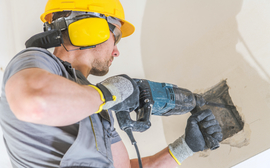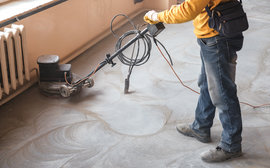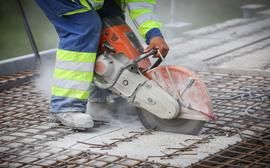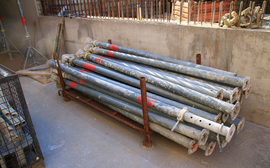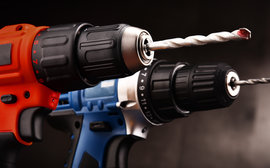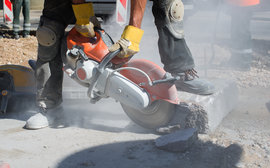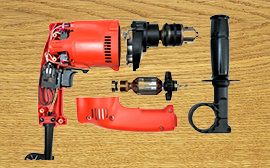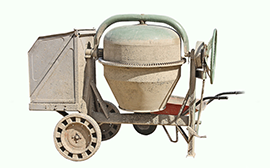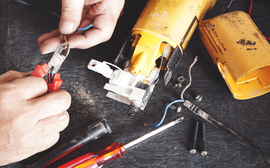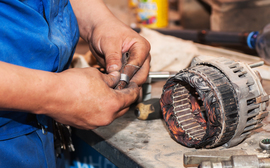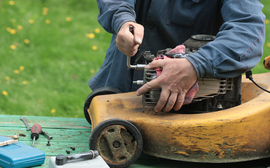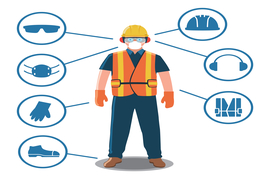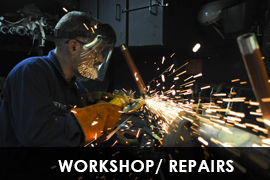- Home
- Safety Guide
Health & Safety
5-Star Safety Service
Safety is our priority at FHP HIRE, which is why we make sure that every piece of equipment you hire from us has been fully and regularly serviced, maintained and tested. Our 5-star approach to safety includes:
Demonstration
Our staff are always happy to demonstrate the controls and features of the equipment you're hiring from us.
Safety instructions
We make sure that all our equipment is supplied to you with full written safety instructions.
Protective equipment
We will advise you on suitable safety clothing and equipment for your hire.
Circuit breakers (RCD)
We can provide a circuit breaker for all 240v equipment.
Safety advice
Our team can provide practical advice on how to use your hire equipment safely.
Hand arm vibration
We are constantly seeking to provide the latest tools designed to minimise the risk of injury from hand arm vibration.
Key to Safety Equipment Symbols

Eye Protection*
We offer a range of certified eye protection to EN 166B. Welding masks are supplied as standard with all welding equipment.

Dust/Spray Mask*
Full range available, from fabric nuisance to fine particle filter.

Ear Defenders*
To safeguard your hearing, we offer general purpose defenders and earplugs.

Protective Gloves*
In all styles and materials to suit the job in hand.

Safety Helmets*
Protection against overhead obstacles and moving objects.

Protective Footwear*
A range of styles and materials to suit the job and working conditions.

Residual Circuit Breakers**
For safer use of all 240v electrical tools and equipment.
Dust Regulations
WHAT ARE THE REGULATIONS?(COSHH REGULATIONS 1999)
To prevent the exposure to crystalline silica dust or, where prevention is not practical, to control the airborne exposure limit to 0.3mg/m3 per 8 hour TWA.
HOW DO THEY AFFECT ME AND MY BUSINESS?
For activity where there is likely to be a creation of dust, the Control of Substances Hazardous to Health Regulations 2002 requires a qualified person to carry out a risk assessment.
WHAT YOUR RISK ASSESSMENT WILL NEED TO COVER
- Analyse your workplace. Are there any hazardous substances? Is there extreme dust exposure?
- Deal with any hazards and eliminate other risks as much as possible. Make sure that you and your workforce are safely equipped to do the job using personal protection equipment. Dust extraction units are available from FHP HIRE Hire
- Employ a safe working ethic by providing staff with information, instruction and training on hazards.
- Look out for our safety icon, which appears next to products that could produce a harmful amount of dust. Dust masks are available to buy from any FHP HIRE branch.
Hand Arm Vibration
WHAT IS HAND ARM VIBRATION?
Hand Arm Vibration is vibration transmitted from hand-held powered work equipment into the hands and arms of the operator. Regular or excessive exposure to Hand Arm Vibration can lead to Hand Arm Vibration Syndrome (HAVS).
WHAT IS HAND ARM VIBRATION SYNDROME?
(Also known as White Finger Disease)
Symptoms
- Tingling in the fingers
- Fingers becoming numb
- Fingers going white
Effects
- Reduced ability to work in cold or damp conditions
- Pain, distress and sleep disturbance
- Loss of strength in your hands
WHEN AM I AT RISK?
You are at risk if you regularly use hand-held power tools and machines such as:
- Brush Cutters
- Chipping Hammers
- Concrete Pokers
- Grinders
- Hedge Trimmers
- Powered Mowers
- Scabblers
- Chainsaws
- Concrete Breakers
- Disc Cutters
- Hammer Drills
- Needle Guns
- Sanders
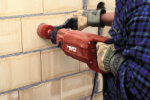
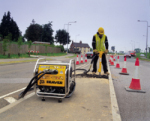
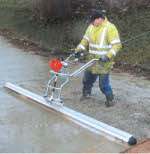
WHAT DOES THIS MEAN TO ME AND MY BUSINESS?
As an employer
Health & Safety Law requires employers to protect their employees by:
- Assessing the job in hand - can it be done another way?
- Look out for the vibration level colour coding throughout the brochure to help you make your assesment using the traffic light system below
- Only use regularly serviced tools (FHP HIRE Hire service all equipment after every use)
- Be alert - do not ignore the symptoms
- Provide reports to the relevant authorities of HAVS cases in your workforce
As an employee
- Learn to recognise early symptoms of HAVS
- Report any symptoms to your employer immediately
- Always use control measures your employer has put in place to reduce the risk of HAVS
Traffic Light System
Developed by The Construction Confederation and Hire Association Europe in partnership with the Health and Safety Executive (HSE), this system categorises the level of vibration caused by the different equipment. FHP HIRE Hire have clearly marked all equipment that applies to Hand Arm Vibration with the appropriate colour.

Over 10m/s2 - High Vibration Risk Equipment
Supervisor needs to assess

5 - 10m/s2 - Medium Vibration Risk Equipment
2 hours maximum daily use without further assessment

Below 5m/s2 - Low Vibration Risk Equipment
8 hours maximum use
Noise Regulations
WHAT ARE THE REGULATIONS?
The Control of Noise at Work Regulations 2005 came into force on 6th April 2006. The regulations aim to ensure workers' hearing is protected from excessive noise at work, which could result in loss of hearing.
HOW DO THEY AFFECT ME AND MY BUSINESS?
As an Employer
- Employers must assess the risks to their workforces' health if the noise exceeds 80 decibels
- Employers must provide hearing protection if noise exceeds 85 decibels (daily or weekly average exposure)
- Employers must not be exposed to noise above the limit of 87 decibels.
- Look out for our safety icon, displayed on products that require you to use ear protection
Ear defenders are available to buy from any FHP HIRE branch.
Manual Handling Regulations
WHAT ARE THE REGULATIONS?
The Manual Handling Operations Regulations 1992 apply to a wide range of manual handling activities, including lifting, lowering, pushing, pulling or carrying of both inanimate (e.g. materials, equipment, boxes) or animate objects (e.g. people).
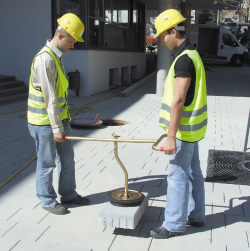
WHY ARE THE REGULATIONS IN PLACE?
Manual handling injuries can occur wherever people are at work with an increased risk in places like building sites, factories and warehouses. Heavy manual labour and manual materials handling can increase the risk of musculoskeletal disorders including:
- Lower back pain
- Joint injuries
- Repetitive strain injuries
These types of injuries affect approximately 1 million people in the UK every year.
WHAT DOES THIS MEAN TO ME AND MY BUSINESS?
As an Employer
The regulations require employers to:
- Avoid - the need for hazardous manual handling, so far as is reasonably practicable.
- Assess - the risk of injury from any hazardous manual handling that can’t be avoided.
- Reduce - the risk of injury from hazardous manual handling, so far as is reasonably practicable.
Mechanisation or handling aids such as conveyors, pallet trucks and hoists should be considered
As an Employee
In accordance with the regulations, employees also have duties too. They should:
- Follow appropriate systems of work laid down for their safety.
- Make proper use of equipment provided for their safety.
- Co-operate with their employer on health and safety matters.
- Inform the employer if they identify hazardous handling activities.
Working at Height Regulations 2005
WHAT ARE THE REGULATIONS?
The regulations provide a simple hierarchy to manage and select appropriate equipment that is most suitable for working at height.
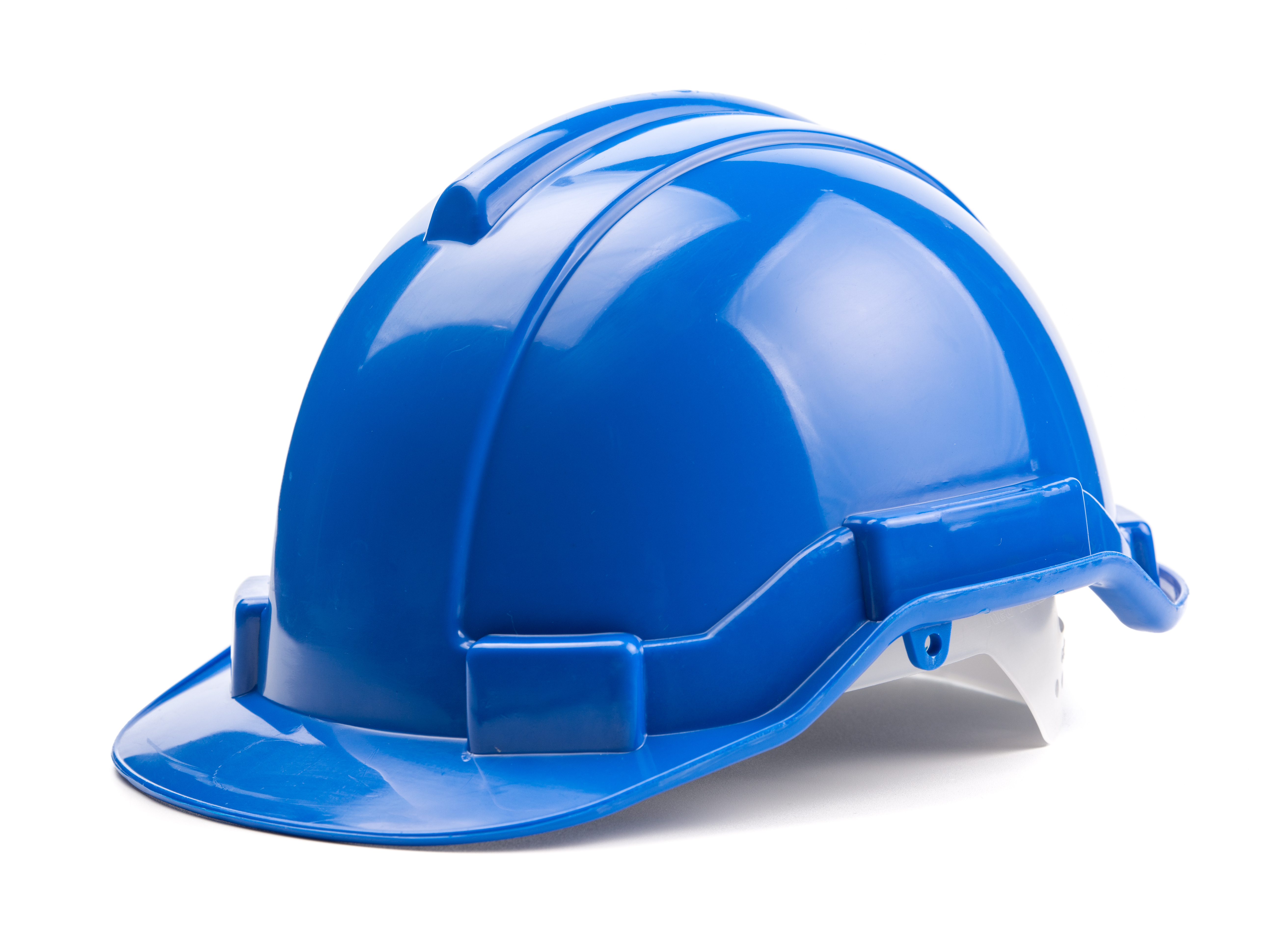
STEP 1: AVOID
Consider the use of other tools available, such as extendable tools or lifting equipment, before working at height.
STEP 2: PREVENT
If you have decided that it is absolutely necessary to work at height, do EVERYTHING you can to prevent a fall:
- Consider the risks before you start
- Assess the environment/working conditions you are working in
- Select the most appropriate/suitable equipment
- Safety harnesses and a full range of Personal Protective Equipment are available to buy from FHP HIRE
STEP 3: MINIMISE
Minimise the consequences of a fall by using the appropriate safety equipment or other measures.
WHO DO THE REGULATIONS APPLY TO?
Anyone, anywhere, at any height - no longer just above 2m.
- Employees
- Self Employed
- Subcontractors
Put Safety First
HOW DO THEY AFFECT ME AND MY BUSINESS?
Standards for work above two metres will not change, they are simply being extended to work at ANY height.
It is your responsibility to ensure that:
- At initial stages before work commences ALL work at height is throughly planned and well organised
- Ensure that all employees/contractors involved are competent
- A full risk assessment is completed on the job in hand, the work environment and surfaces. This is then used to select the most appropriate equipment (FHP HIRE Hire staff can provide guidance on all equipment)
- Ensure all equipment for working at height is properly used, maintained and inspected.
WARNING
Even when no injuries result - The Work at Height Regulations 2005 allow people who do not work safely to be prosecuted.
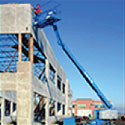

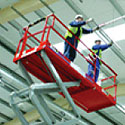
-
Hire
- Access
- Breaking & Drilling
- Cleaning & Preparation
-
Compressed Air
- Concreting & Finishing
-
Cutting & Grinding
-
Fixing
- Gardening
-
General Building & Siteworks
-
Generator & Site Electrics
-
Groundworks
-
Heating & Cooling
-
Lifting & Handling
-
Lighting
-
Painting & Decorating
-
Pipework & Engineering
-
Pumping
-
Safety Equipment
-
Snow equipment
-
Survey Equipment
-
Welding Equipment
-
Woodworking
- Sale
-
Repair
- Access
- Breaking & Drilling
-
Cleaning & Preparation
-
Compressed Air
-
Concreting & Finishing
-
Cutting & Grinding
-
Fixing
- Gardening
-
General Building & Siteworks
- Generator & Site Electrics
-
Groundworks
-
Heating & Cooling
-
Lifting & Handling
-
Lighting
-
Pipework & Engineering
-
Pumping
-
Safety Equipment
-
Survey Equipment
-
Woodworking
- Health & Safety
- Company
- Contact Us


